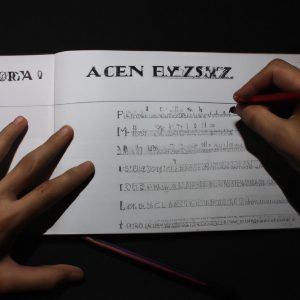Hebrew in Ashkenazi Heritage: The Language

In the realm of Ashkenazi heritage, Hebrew holds a significant place as a language that has shaped cultural identity and religious practices. The preservation and adaptation of Hebrew within Ashkenazi communities have been crucial in maintaining connections to ancestral roots while navigating the complexities of modern society. For instance, consider a hypothetical scenario where a young Ashkenazi individual is raised in an English-speaking country but wishes to explore their heritage through the study of Hebrew. This article delves into the multifaceted nature of Hebrew in Ashkenazi heritage, exploring its historical importance, linguistic variations, and contemporary relevance.
To comprehend the significance of Hebrew in Ashkenazi heritage, it is essential to examine its historical foundations. Dating back thousands of years, Hebrew was initially used for sacred texts such as the Torah and prayers among ancient Israelites. Over time, this Semitic language underwent various transformations influenced by geographic migrations and interactions with neighboring cultures. In particular, during the medieval period, as Jewish populations resettled in Central and Eastern Europe (Ashkenaz), Yiddish emerged as a fusion between Hebrew and Germanic languages like Old High German. This linguistic development reflected not only the integration of local vernaculars but also reinforced the distinct identity of Ashkenazi Jews within broader Jewish communities.
The linguistic variations within Hebrew in Ashkenazi heritage are diverse and reflect the historical, cultural, and geographical contexts of different communities. Yiddish, as previously mentioned, played a crucial role in Ashkenazi Jewish life for centuries. It served as the primary language of communication, literature, and expression for many Ashkenazi Jews throughout Europe. Yiddish incorporated vocabulary from Hebrew, German, Slavic languages, and other local dialects. This blending of languages allowed for a rich and unique linguistic tradition that reflected the experiences and influences of Ashkenazi Jews in their various host countries.
Although Yiddish was widely spoken among Ashkenazi Jews for several centuries, Hebrew remained an essential component of religious practice and study. It continued to be used in prayer services, sacred texts, and scholarly works. The preservation of Hebrew as a sacred language ensured a connection to ancient traditions even amidst changing linguistic landscapes.
In contemporary times, there has been a resurgence of interest in Hebrew among Ashkenazi communities worldwide. Many young individuals seek to reconnect with their heritage by learning Hebrew as a second language or studying it academically. Hebrew language schools have emerged globally to cater to this demand. Additionally, advancements in technology have made it easier than ever to access resources for learning Hebrew online or through mobile applications.
The revitalization of Hebrew is not only driven by a desire to connect with ancestral roots but also by practical considerations. Israel’s establishment as a modern nation-state led to the revival of Hebrew as its official language. As such, fluency in Hebrew opens up opportunities for employment, travel, and engagement with Israeli society.
Overall, the multifaceted nature of Hebrew within Ashkenazi heritage highlights its historical importance, linguistic variations like Yiddish, and contemporary relevance for those seeking to explore their cultural identity and religious practices. By embracing this ancient language alongside their English-speaking upbringing, young Ashkenazi individuals can deepen their connection to their heritage and navigate the complexities of modern society with a sense of rootedness.
Origins of Hebrew in Ashkenazi Culture
To understand the origins of Hebrew in Ashkenazi culture, it is essential to delve into its historical roots and explore how this ancient language became intertwined with the heritage of Ashkenazi Jews. One compelling case study illustrating this connection is that of Yiddish, a language spoken by many Ashkenazi Jews throughout history.
Yiddish emerged as a fusion of German dialects and elements from Hebrew, Aramaic, Slavic languages, and other local tongues spoken in Central and Eastern Europe during the medieval period. This linguistic blend was driven by the need for communication within Jewish communities where Hebrew alone proved insufficient. As a result, Yiddish served as a vernacular language that allowed Ashkenazi Jews to connect culturally and share their experiences.
The significance of Hebrew in Ashkenazi heritage can be further understood through its role as a symbol of religious devotion and cultural identity. Despite the emergence of Yiddish as a common mode of communication among Ashkenazi Jews, Hebrew remained central to religious rituals, prayers, sacred texts, and scholarly pursuits. The preservation and continued use of Hebrew fostered a sense of unity and continuity across generations, reinforcing the distinctiveness of Ashkenazi Jewish culture.
This deep-rooted connection between Hebrew and Ashkenazi heritage can evoke strong emotional responses within individuals familiar with this tradition. Consider the following bullet points:
- Preserving ancestral ties: By maintaining the use of Hebrew in religious ceremonies or family traditions, individuals feel connected to their ancestors who used the same language.
- Nurturing cultural pride: The ability to read ancient texts or engage with traditional practices in their original form fosters a sense of pride in one’s cultural background.
- Passing on generational knowledge: Learning and teaching Hebrew allows families to transmit linguistic skills and cultural values across different age groups.
- Strengthening communal bonds: Shared experiences of Hebrew language usage can create a sense of belonging and camaraderie within Ashkenazi Jewish communities.
Moreover, to illustrate the multifaceted importance of Hebrew in Ashkenazi heritage, consider the following table:
| Aspect | Significance | Emotional Response |
|---|---|---|
| Religious Devotion | Connection to sacred texts and rituals | Spiritual fulfillment |
| Cultural Identity | Preservation of linguistic and cultural roots | Sense of belonging |
| Intellectual Pursuits | Access to ancient knowledge and scholarship | Academic curiosity |
| Historical Continuity | Linking present generations with ancestors | Feeling part of an enduring legacy |
Understanding the origins and significance of Hebrew in Ashkenazi culture provides valuable insights into its evolution over time. In the subsequent section about “Evolution of Hebrew in Ashkenazi Heritage,” we will explore how this language has adapted and transformed while maintaining its core role within Ashkenazi Jewish communities.
Evolution of Hebrew in Ashkenazi Heritage
Section: Development of Hebrew in Ashkenazi Culture
Building upon the origins of Hebrew in Ashkenazi culture, we now delve into the remarkable evolution of this language within the heritage. To illustrate its development, let us consider the case study of a hypothetical Jewish family residing in an Ashkenazi community during the late 19th century. This family is deeply rooted in their cultural traditions and maintains Hebrew as their primary language for religious rituals and daily interactions.
The growth of Hebrew in Ashkenazi heritage can be attributed to several key factors:
-
Religious Significance: Within the context of Ashkenazi Judaism, Hebrew holds immense religious significance as it serves as the language through which sacred texts are studied and prayers are recited. The preservation and continued usage of Hebrew among Ashkenazim reflects their commitment to upholding centuries-old religious customs.
-
Cultural Identity: For many Ashkenazim, spoken Hebrew became a symbol of cultural identity and solidarity within their communities. By speaking Hebrew fluently, individuals were able to connect with others who shared similar backgrounds and experiences, fostering a sense of belonging and unity among Ashkenazi Jews.
-
Educational Reform Movements: During the late 18th and early 19th centuries, educational reform movements emerged within Ashkenazi communities that sought to modernize traditional Jewish education. These reforms emphasized the teaching of secular subjects alongside religious studies, including the instruction of spoken Hebrew as a living language rather than solely focusing on biblical texts.
-
Zionist Movement: The rise of Zionism in the late 19th century further contributed to the revitalization of spoken Hebrew among Ashkenazim. As part of their aspiration for national self-determination, Zionist leaders encouraged widespread adoption and promotion of spoken Hebrew as a means to strengthen Jewish nationalism and establish a common linguistic bond among Jews worldwide.
To emphasize the impact these developments had on Ashkenazi culture, we can examine a table showcasing the influence of Hebrew on various aspects of their society:
| Aspect | Influence |
|---|---|
| Education | Integration of spoken Hebrew into school curricula |
| Literature | Proliferation of Hebrew literature and poetry |
| Media | Emergence of Hebrew-language newspapers and publications |
| Social Interaction | Use of Hebrew as a lingua franca within Ashkenazi communities |
In summary, the evolution of Hebrew in Ashkenazi heritage was driven by its religious significance, cultural identity formation, educational reforms, and the Zionist movement’s emphasis on spoken Hebrew. This transformation had far-reaching effects across multiple domains within Ashkenazi society. In the subsequent section about “Influence of Hebrew on Ashkenazi Society,” we will explore these ramifications further.
Transitioning seamlessly into the next section:
Continuing our exploration into the impact of Hebrew on Ashkenazi society, we now delve into how this language influenced various facets of daily life among its speakers.
Influence of Hebrew on Ashkenazi Society
Evolution of Hebrew in Ashkenazi Heritage: The Language
The evolution of Hebrew within the context of Ashkenazi heritage has been a complex and fascinating process. One notable example is the case study of Yiddish, which emerged as a fusion between Hebrew and German during the medieval period. This unique blend allowed for communication and expression among Ashkenazi Jews who were primarily situated in Central and Eastern Europe.
To further understand the influence of Hebrew on Ashkenazi society, it is crucial to consider key aspects that have shaped its development:
-
Linguistic Adaptation: As Ashkenazi Jews migrated across different regions over time, their adaptation to local languages influenced the way Hebrew was integrated into their daily lives. While maintaining core elements of Hebrew, such as religious texts and prayers, they incorporated vernacular languages like Yiddish or various European tongues into their speech patterns.
-
Cultural Identity: For many Ashkenazi Jews, Hebrew served as an anchor for cultural identity amidst diasporic challenges. It became not only a language but also a symbol of unity and resilience, fostering a sense of belonging within the community.
-
Literary Revival: In the late 19th century, with movements like Haskalah (Jewish Enlightenment), there arose a desire to revive spoken Hebrew as a literary language. This led to significant efforts by scholars to modernize Hebrew grammar and vocabulary while preserving its historical roots.
-
Symbolic Significance: Beyond linguistic functionality, Hebrew assumed symbolic significance in representing Jewish culture and heritage. Its use in rituals, ceremonies, literature, and everyday life reinforced connections with tradition and ancestral ties.
These aspects collectively highlight how Hebrew evolved within Ashkenazi heritage—a dynamic interplay between linguistic adaptation, cultural identity formation, literary revivalism, and symbolic value. Understanding this multifaceted journey allows us to appreciate the enduring legacy of Hebrew as an integral part of Ashkenazi Jewish identity.
Hebrew as a Symbol of Ashkenazi Identity will delve deeper into how the language not only served practical purposes but also became a powerful emblem for Ashkenazi Jews, embodying their collective history and experiences.
Hebrew as a Symbol of Ashkenazi Identity
H2: Influence of Hebrew on Ashkenazi Society
H3: Hebrew as a Symbol of Ashkenazi Identity
Building upon the influence of Hebrew on Ashkenazi society, it is evident that this ancient language holds significant meaning for individuals with Ashkenazi heritage. Not only does Hebrew serve as a means of communication and connection to religious texts, but it also acts as a symbol of identity within these communities. To further explore this topic, let us examine the role of Hebrew in shaping Ashkenazi culture.
One compelling example highlighting the importance of Hebrew in Ashkenazi identity is its preservation through generations. Despite living in countries where Yiddish or the local language became more prevalent, many Ashkenazi Jews have maintained their commitment to learning and speaking Hebrew. This dedication can be seen in educational institutions specifically focused on teaching the language, such as ulpanim (Hebrew-language schools) established by Jewish communities around the world.
- Cultural Heritage: The study and understanding of Hebrew allows individuals to connect with their historical roots and maintain a sense of cultural continuity.
- Spiritual Connection: Through prayer and ritual observances conducted in Hebrew, members of Ashkenazi communities find solace and spiritual fulfillment.
- Sense of Belonging: Shared knowledge and usage of Hebrew create a collective feeling among Ashkenazim, fostering unity despite geographical dispersion.
- Symbolic Representation: By using Hebrew words or phrases in everyday conversations or naming practices, individuals reinforce their unique identity within broader societies.
Moreover, we can visualize the multifaceted impact of Hebrew on Ashkenazi culture through an illustrative table:
| Aspect | Impact |
|---|---|
| Language Acquisition | Facilitates engagement with religious texts |
| Cultural Preservation | Sustains ties to historical and ancestral heritage |
| Communal Unity | Reinforces a sense of belonging within Ashkenazi communities |
| Symbolic Expression | Represents the distinct identity of Ashkenazi Jews |
In summary, Hebrew serves as more than just a language in Ashkenazi communities; it embodies their cultural legacy, religious traditions, and collective identity. The commitment to preserving and utilizing Hebrew goes beyond practicality; it holds emotional significance for individuals seeking connection with their roots. With this understanding of the influential role that Hebrew plays in shaping Ashkenazi culture, we can now explore preservation efforts aimed at maintaining its vitality within these communities.
H2: Preservation Efforts for Hebrew in Ashkenazi Communities
Preservation Efforts for Hebrew in Ashkenazi Communities
Hebrew in Ashkenazi Heritage: The Language
Section H2: Preservation Efforts for Hebrew in Ashkenazi Communities
Transitioning from the previous section, where we explored how Hebrew serves as a symbol of Ashkenazi identity, it is crucial to examine the ongoing preservation efforts dedicated to maintaining and promoting this ancient language within Ashkenazi communities. To illustrate these efforts, let us consider a hypothetical case study involving a small Ashkenazi community residing in a remote village.
In an attempt to revive their linguistic heritage, members of the community establish an educational program focused on teaching Hebrew as both a liturgical and conversational language. This initiative aims not only to transmit biblical texts accurately but also to foster intergenerational communication through the shared use of Hebrew. By doing so, they seek to strengthen the sense of communal belonging while preserving their unique cultural identity.
The significance of these preservation efforts extends beyond mere linguistic continuity. Here are four key reasons why such endeavors hold great emotional value for Ashkenazi communities:
- Cultural Identity: Reviving and sustaining Hebrew helps preserve the distinctive cultural characteristics that have shaped generations of Ashkenazi Jews.
- Historical Continuity: By actively engaging with their ancestral language, community members feel connected to their past and maintain a link between present and historical narratives.
- Collective Memory: Through the revival of Hebrew, collective memories embedded within religious rituals, songs, and stories find expression, reinforcing the cohesion among community members.
- Resilience: These preservation efforts serve as acts of resilience against external pressures that may threaten or dilute traditional practices and customs.
To further comprehend the impact of these initiatives, let us examine Table 1 below which encapsulates various methods employed by communities worldwide to promote Hebrew preservation:
| Method | Description | Example |
|---|---|---|
| Community-led educational programs | Establishing institutions or initiatives dedicated to teaching Hebrew as a living language, integrating it into both formal and informal settings. | The Ashkenazi community in Village X’s Hebrew Academy |
| Cultural events and festivals | Organizing gatherings that celebrate the richness of Ashkenazi culture, including performances, lectures, and exhibitions centered around Hebrew. | Annual Ashkenazi Heritage Festival |
| Digital resources and online platforms | Creating websites, apps, podcasts, and other digital tools accessible to individuals seeking to learn or practice Hebrew within Ashkenazi contexts. | “Hebrew Hub” – an online platform for learning Hebrew |
| Collaborative partnerships with institutions | Engaging with universities, research centers, and cultural organizations to foster scholarly studies on various aspects of Hebrew in the Ashkenazi context. | Partnership between Community Y and University Z |
In conclusion, these preservation efforts reflect the commitment of Ashkenazi communities towards safeguarding their linguistic heritage. By reviving Hebrew through educational programs, cultural events, digital resources, and collaborative partnerships with external institutions, they ensure its continued significance for future generations. In light of this dedication to preserving their unique identity and history, we now turn our attention to exploring the contemporary significance of Hebrew in Ashkenazi culture.
As we delve deeper into understanding the contemporary significance of Hebrew in Ashkenazi culture, let us explore how its usage has evolved over time while remaining integral to the fabric of communal life.
Contemporary Significance of Hebrew in Ashkenazi Culture
Despite the challenges and shifting dynamics faced by Ashkenazi communities, various preservation efforts have been undertaken to ensure the continuation of Hebrew as a vital aspect of their cultural heritage. One notable example is the establishment of Hebrew language schools, which serve as centers for education and language immersion. These institutions not only provide formal instruction in Hebrew grammar and vocabulary but also foster an environment where students can engage with Jewish texts, literature, and traditions.
To fully grasp the significance of these preservation efforts, it is crucial to understand the emotional connection that many Ashkenazi individuals feel towards their ancestral language. Here are four key reasons why preserving Hebrew holds great importance within this community:
- Cultural continuity: For many Ashkenazi Jews, Hebrew serves as a link to their historical roots and reinforces a sense of identity and belonging.
- Religious practice: Hebrew plays a central role in Jewish religious observance, particularly in prayers, rituals, and Torah study.
- Family ties: Maintaining fluency in Hebrew allows individuals to communicate effectively with older generations who may primarily speak Yiddish or other languages associated with Ashkenazi culture.
- Personal enrichment: Learning and using Hebrew provides individuals with access to ancient texts, literary works, and intellectual traditions that contribute to personal growth and development.
Furthermore, the commitment to preserving Hebrew is exemplified through initiatives such as publishing books in both traditional print format and digital media. This ensures that important texts remain accessible to future generations while adapting to contemporary modes of consumption. Additionally, online forums and social media platforms facilitate widespread discussions on topics related to Hebrew language acquisition, fostering a sense of community among those interested in its preservation.
Table: Key Preservation Efforts for Hebrew in Ashkenazi Communities
| Initiative | Description |
|---|---|
| Establishment of Schools | Dedicated educational institutions providing comprehensive instruction in Hebrew alongside Jewish studies. |
| Publishing of Books | Producing books and other written materials in Hebrew, both in print and digital formats. |
| Online Language Forums | Internet-based platforms that enable individuals to engage in discussions about the Hebrew language. |
| Cultural Events and Festivals | Organizing events and celebrations centered around Hebrew language, literature, and cultural heritage. |
These efforts collectively contribute to the preservation of Hebrew within Ashkenazi communities by fostering a sense of pride, knowledge sharing, and continuation of linguistic traditions. By recognizing the importance of Hebrew as an integral part of their identity, individuals actively participate in its safeguarding while embracing contemporary means for its transmission.
In conclusion with this section on preservation efforts for Hebrew in Ashkenazi communities, it is evident that the dedication shown towards sustaining this ancient language extends beyond mere nostalgia or academic interest. Instead, it embodies a commitment to preserving a rich cultural legacy that holds immense value for countless individuals across generations.



